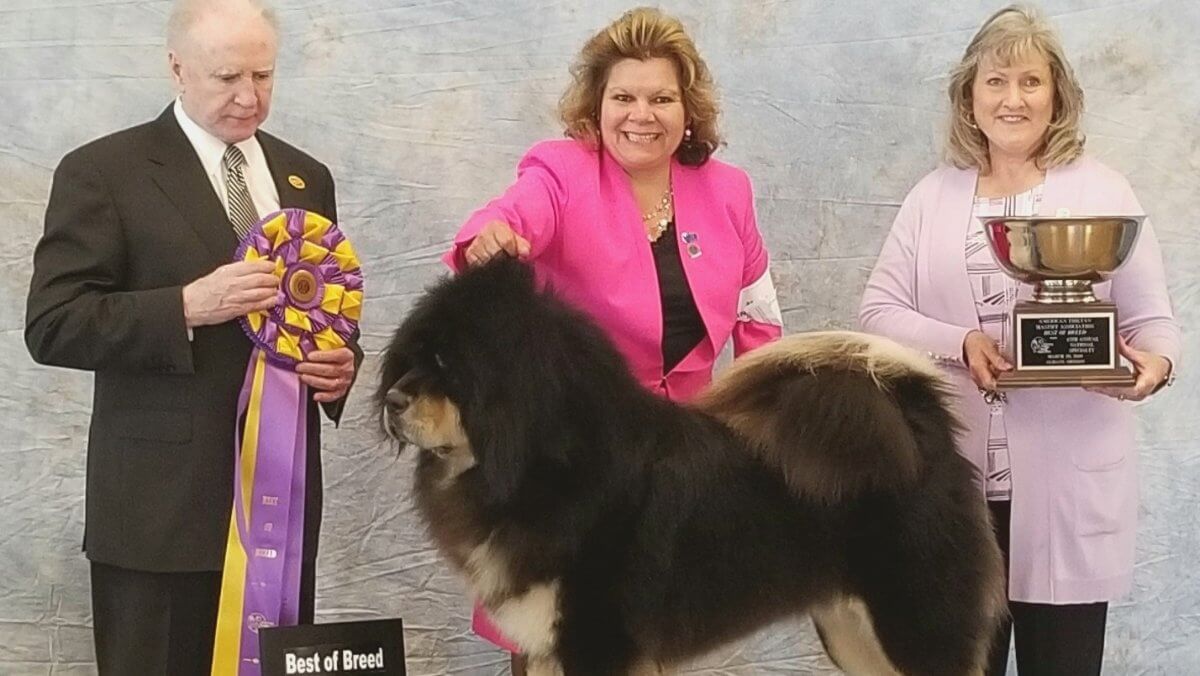Interview with Debra Parsons Slayton, Breeder of DreamCatcher Tibetan Mastiffs
- Please tell us a little bit about yourself. Where do you live? How many years in dogs? How many years as a breeder? What is your kennel name?
- What is your “process” for selecting show puppies? Performance puppies?
- In your opinion, is your breed in good condition overall? Any trends that warrant concern?
- As a Preservation Breeder, can you share your thoughts on the sport today? How’s the judging these days? What do you think about the number of shows?
- In your opinion, is social media good for the sport? Is it harmful?
- What are the biggest challenges facing the dog show community as a whole today and how can these be addressed?
- What are some of the positive changes you’ve seen in the sport over the past decade?
Debra Parsons Slayton
1. DreamCatcher Tibetan Mastiffs has been in Tibetans here in the United States since 1999. We started out in Phoenix, Arizona, and now have been in Graham, Washington, for the past 20 years. We have been exclusively in Tibetan Mastiffs (TM) since 1999. We have worked over the years with foundation breeders, Rick Eichhorn at Drakyi Kennels and Sabrina Novarra (retired) at Shang-Hai Kennels. A joining of the two lines in 2007 produced the famous Lokevie Litter that, today, generations later, the lines and beauty still prevail in the breed worldwide. Concentration has been on structure, head type, substantial bone, gorgeous angulation, movement, and most importantly, temperament.
2. I am a devotee of Pat Hastings and the Puppy Puzzle, and a BIG believer in puppy evaluations at six weeks. If the puppies were here in Washington, I have had Pat here while she was still active to evaluate my litters. Now I try to have other friends locally who are judges come to evaluate them at six weeks. I treasure those evaluations, and the look and reviews that these experienced judges have to see what I might miss—and give credence to the attributes I am working toward.
3. Over the past 2-3 years, the breed has taken a giant step back overall. Head type is disappearing, being replaced with a long, narrow head that doesn’t look at all like the TM head. With that, we are also seeing a destruction of the overall structure that has led to a lack of substance/bone and movement. It seems we may be breeding just to breed and not truly studying the lines to understand what will bring out the best in the select pair. If it won’t produce the Breed Standard, there must be a substantial reason to support the breeding or just don’t do it.
Concerning trends include loss of head type, skinny-boned, no angulation, bad rears, and ultimately, movement is being sacrificed. Judges just don’t seem to know the Standard or are perhaps just judging the ring vs. the Standard, “every dog” wins a ribbon when, really, some that are getting champion titles truly do not deserve them.
4. I feel like, in our breed, judges are getting their stamps on Tibetan Mastiffs without any knowledge or hands-on experience with the breed. Not for lack of ATMA’s trying at our National and annually at the National Championships. It is going to be critical that the new judges coming on know that the headpiece is the hallmark of the breed; that the cat-like feet are critical to their movement. I could go on and on.
How’s the judging? I serve as the President and Show Chair of the Mt. Rainier Working Dog Club. We are mostly judges and breeders. We all have great concerns about how AKC can best increase the number of new, younger generations to enter the judging ranks. And the number of shows? Many of our shows in the Northwest have combined and added days, so it feels like we are still having plenty of opportunities to work on titles.
5. Social media may have its place in today’s society, but it is harmful to all, in my opinion. It is an oversized, nasty bully pulpit.
6. The AKC, superintendents, judges, and exhibitors as a whole are aging out. I think a lot of people feel it is a dying sport. Breed and Specialty clubs are struggling to find young, new members to keep these long-established clubs going, which will ultimately affect the number and quality of the available shows for exhibitors.
7. We are trying to increase the level of titles at DreamCatcher and Aujudon to include more of the Performance opportunities. We are dedicated to the Canine Good Citizen title, and many of the new, fun ones are good and doable with Tibetan Mastiffs. (If you know, you know.)








